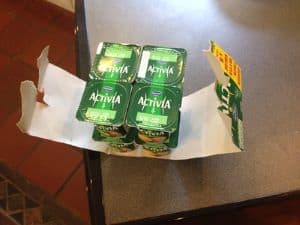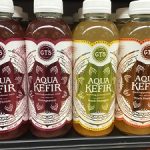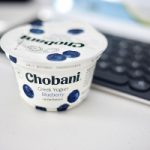
Who are Activia?
Activia is a company dedicated to researching probiotics and how they improve gut health.
They provide several different probiotic yoghurt products, including some designed for children. They believe that gut health is important to overall health.
Why might Activia help dogs?
Pets can develop gut problems just like people can.
Dogs are known for it, as they will often eat things they shouldn’t. When that happens, probiotics can help your dog get over a mild gut problem in a natural way.
Activia uses a special method to create its yoghurt.
There are five different fermenters in the product.
These are bacteria strains that dine off of the lactose in yoghurt, turning it into lactic acid.
While not all of the lactose is consumed by the bacteria, enough is so that it is less likely to cause problems for those who have difficulties in that department.
Most of us think of bacteria as being bad, but in order to have a healthy gut, we and our pets need to have good bacteria in it.
This keeps the bad bacteria and things like candida yeast under control. Without it, we quickly become ill. So do our pets.
Is milk a healthy ingredient for a dog?
That depends on a large number of factors.
Some dogs can both tolerate and enjoy a few tablespoons of milk, and some milk products are easier to digest than others.
Milk is often an ingredient in dog treats, so under those conditions, yes.
On the other hand, according to the American Kennel Association, milk and dairy products are one of the leading food intolerances found in dogs.
This is usually due to the lactose content. That is another area that has to be considered.
Should dogs who are lactose intolerant be given yoghurt?
That is usually individual to the dog.
Because the bacteria in yoghurt eat the lactose, most dogs can handle small amounts. It is important to make sure that it is an active culture yoghurt such as Activia.
What other ingredients in Activia yogurts are unhealthy?
This very much depends on which product you choose.
Yoghurt with fruit may have added sugars, which would be a bad plan for dogs. Some fruits may be toxic to dogs.
This would include grapes and raisins, which are in some of their other products.
Activia does make yoghurt with nut milk, such as almond milk. While it still contains active bacteria, the dog may have some digestive issues from it.
Dogs weren’t designed to digest almonds, so it can be a bit problematic. Check with your vet before giving almond milk yoghurt… or the milk itself… to your dog.
How much yoghurt should I feed my dog every day?
Depending on the dog’s size, one to three tablespoons per day is the right amount.
How many times a week and for how long will depend on your dog’s reaction to the yoghurt, whether or not it’s helping and instructions from your vet.
What other foods contain probiotics?
Most fermented foods have probiotics. I say most because although beer is fermented, it does not usually have any live culture. There are several that can be used, and some dogs actually like a few of them.
Miso is one, although it is best to make sure it doesn’t contain MSG. It can be incorporated into the dog’s food or it can be given separately. The paste can be found in most major grocery stores or an Asian food market.
Kombucha: This is a fermented drink made partially from black tea. The fermentation process takes care of such problems as caffeine, but some dogs won’t drink it. Owners tend to mix it into the dog’s food, especially if the dog is on a raw diet.
Some dogs can’t have Kombucha. Those with acid reflux should not be given the fizzy beverage. It’s also wise to avoid flavored Kombucha because it may have added sugar or other ingredients that aren’t good for your dog.
DIY fermented foods
Most vegetables and some fruits can be fermented at home. As long as the vegetables are dog friendly, they can be used. That includes leftovers from your own meal preparations. It’s best to skip anything from the onion family, but things like broccoli, kale, carrots and watermelon rinds can all be used.
Throw them (and maybe an organic banana peel or two) into your food processor and chop it small. Add a bit of salt and compress it. Cover and wait for two hours. If the veggies have not produced enough liquid on their own, add water until everything is covered. Any uncovered veggies will get moldy.
Most folks allow the mixture to ferment on the counter. You may see some mold growing on top of the liquid… that’s fine. When it is fermented, you can scrape it off. A dog can have up to thirty percent of its food as vegetables, though most keep it around twenty percent. Exact amounts are too dependent on the dog’s size.
What other simple hacks are there to help your dog’s digestion?
True pumpkin puree is one choice that is often good for dogs. Don’t get pumpkin pie filling because it’s usually not made from pumpkin and it contains extra sugar plus other ingredients.
If your dog tends to scarf its food as fast as it can, you’ll want to slow him or her down some. Eating quickly can cause several problems, and digestive issues are one of them. Smaller portions more frequently may be one solution.
As mentioned above, some dogs are on a raw diet. Fresh foods are good for the dog’s digestion. Either raw or gently cooked meat may be of some benefit. Beware switching immediately to a new diet; dogs need to have the change made gradually.
Like humans, dogs need to stay hydrated. One way to improve digestion is to make sure that the dog has a good, long drink of water before his or her meal. This may also help the speed eating dog slow down. Overfeeding a dog can also lead to digestive issues… among other things. Giving lots of treats can be problematic, even though the dog doesn’t seem to think so.
While it isn’t necessary to buy fancy designer brand dog foods, quality is important. Read the ingredients label to make sure it has everything your dog needs and nothing it doesn’t. If it isn’t at least seventy percent meat, it isn’t a good food for your dog. You can also check the nutrition label to make sure it is healthy.
Can dogs eat Activia yoghurt?
Yes, dogs can eat Activia or other yoghurts. However, there are a lot of things to consider before purchasing yoghurt of any type. First of all, read the ingredients list. Sugar free yoghurt may contain xylitol, which could kill your pet.
It’s equally important to make sure that the yoghurt has active culture. Some don’t, and those won’t do your pet a lot of good. Activia has five fermenters in it, which is considered very good. The company also has a plain, Greek yoghurt which is ideal for dogs.
Some dogs can’t tolerate yoghurt due to the dairy in it. Although the bacteria eat most of the lactose, some may remain and very sensitive dogs could have a reaction. Watch for symptoms of lactose intolerance and avoid all dairy if the dog has a problem with it.
It might be a good idea to consider other fermented products for your dog, especially if it is lactose intolerant. It doesn’t have to be fancy; it can even be made at home. Once the fermentation starts, it can be kept up by continually adding ground up fruits and vegetables.
Having canned pumpkin… that contains real pumpkin… on hand is a good plan, as it can be used as needed to improve digestion should a minor hiccup occur. You can also cook pumpkin, grind it up and freeze it for later use if the dog is likely to need it frequently.
Healthy food makes for a healthy dog. Check for sodium content, extra sugar and other ingredients that aren’t helpful for your dog. Too much fat is also a bad plan, leading both to digestive issues and long term problems.
Always talk to your vet about foods for your pet. The vet will know if the dog has any special needs and can also give you the amounts/schedule for feeding. This helps prevent overfeeding and can also stop other problems from cropping up.
Any time you are going to make a major change in your dog’s food, do it slowly. Start it at one quarter new food to three quarters old food and gradually move it until it’s all one. This helps prevent problems the change could make.
Resources
http://www.drheartway.com/2014/11/11/fermented-foods-for-dogs-and-cats/





